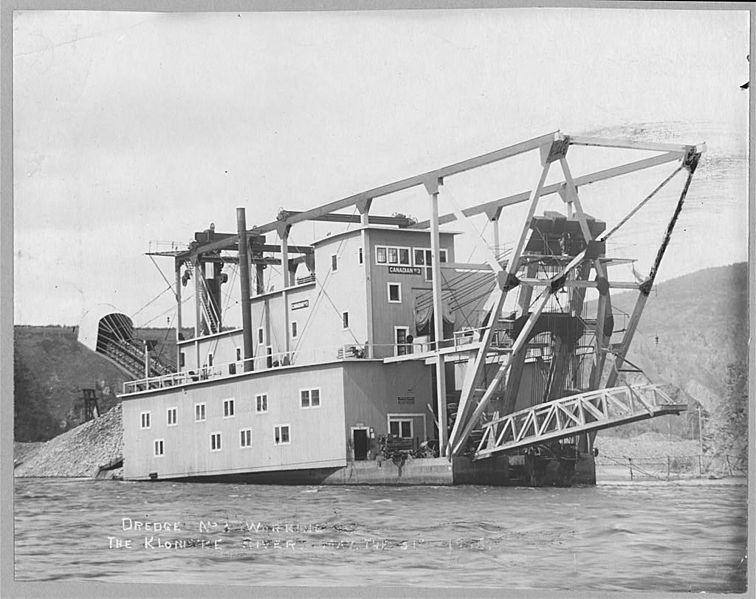Image: KlondikeDredge

Description: Dredge no. 3, working in the Klondike River, May the 31st, 1915.
Klondike Gold Rush in Canada — The photographer was facing the right front corner of the dredge. The bucketline of the dredge is mostly not visible (some buckets can be seen) because the bucketline has been lowered to or near the dredge's maximum digging depth. The bucketline is at the front center of the dredge and it goes through the visible notch in the dredge deck. The ladder (the steel structure that has many visible cables in the front center of the dredge) supports the bucketline.
This particular dredge is large, so its maximum digging depth is at least sixteen feet underneath itself. The dredge is rearing back. The bucketline may have scraped on bedrock a couple seconds before the instant of the photograph. The intermittence of the tailings on and falling from the stacker at the rear of the dredge may be evidence that the dredge is digging near bedrock. The dirty-looking stream of water from the end of the sluice box near the lower-left corner of the photograph indicates that the dredge was working at the instant of the photograph. The bridge-like structure protruding from the right front area of the dredge deck was used for access to and from the dredge. The end of the walkway may have been capable of being raised or lowered: note the cable attached to the yoke near the end of the walkway. A small boat may have been used for access to this dredge, or the dredge may have been "parked" for longer periods (during cleanup when the dredge was shut down to collect gold from the sluice box, for example) so the walkway would be accessible from shore. The current of the river can be seen to be flowing; the dredge is facing upstream. The winchroom (where the winchman pulled levers to mechanically operate a clutch and a brake for each winch, thereby controlling the dredge) is at the top of the dredge house where the row of six windows can be seen at the front of the dredge. Note the extra lower window directly above the bucketline that gave the winchman a view of the bucketline. The dredge is large enough that it probably had two spuds (a spud was a large, heavy, nail-like thing at the rear of the dredge that fixed the dredge in one spot so the dredge could mine efficiently by partially rotating about the spud). The top of the right-side spud is visible, but the top of the left-side spud is not visible; the dredge was probably using the left-side spud at the instant of the photograph.
Usage Terms: Public domain
Image usage
There are no pages that link to this image.

